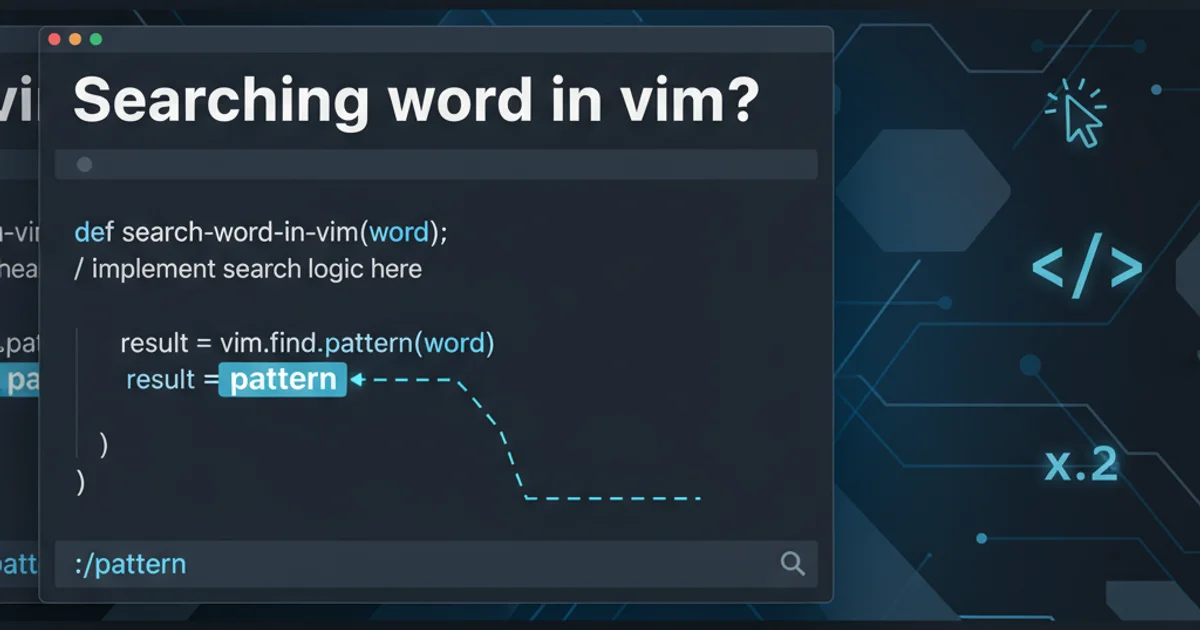Searching word in vim?
Categories:
Mastering Word Search in Vim: A Comprehensive Guide

Unlock the full potential of Vim's powerful search capabilities, from basic word matching to advanced regular expressions and navigation techniques.
Vim, the highly configurable text editor, offers a robust set of tools for navigating and manipulating text. One of its most fundamental and frequently used features is searching. Whether you're looking for a specific word, a pattern, or trying to jump between occurrences, Vim provides efficient commands to get the job done. This article will guide you through various methods of searching for words in Vim, from simple exact matches to more complex pattern-based searches, and how to effectively navigate through your search results.
Basic Word Search: Exact Matches
The simplest way to search for a word in Vim is to use the forward search command / followed by the word you want to find. Vim will highlight the first occurrence after your current cursor position. To search backward, use ? instead of /.
/word_to_find
?word_to_find
Basic forward and backward search commands
n to jump to the next occurrence (forward) and N to jump to the previous occurrence (backward). This allows for quick navigation through all matches.Searching for the Word Under the Cursor
Often, you'll want to search for the word your cursor is currently on. Vim provides convenient shortcuts for this, saving you the trouble of typing the word manually. This is particularly useful for long or complex identifiers.
*
#
Searching for the word under the cursor
The * command searches forward for the word under the cursor, treating it as a whole word (using \< and \> delimiters). The # command does the same but searches backward. These commands are case-sensitive by default, but this can be changed with Vim options.
flowchart TD
A[Cursor on 'example'] --> B{"Press '*'"}
B --> C[Search forward for '\<example\>']
C --> D[Highlight first match after cursor]
D --> E{"Press 'n'"}
E --> F[Go to next match]
B --> G{"Press '#'"}
G --> H[Search backward for '\<example\>']
H --> I[Highlight first match before cursor]Workflow for searching the word under the cursor
Advanced Search with Regular Expressions
Vim's search functionality is powered by regular expressions, offering immense flexibility for pattern matching. You can search for partial words, specific character sets, or complex patterns. Understanding basic regex syntax significantly enhances your search capabilities.
/^function\s\+\w\+\s*(
/error\|warning
/\<[A-Z][a-zA-Z0-9_]*\>
Examples of regular expression searches
. (any character), * (zero or more of the preceding), + (one or more of the preceding), \? (zero or one of the preceding), \< (word boundary start), \> (word boundary end), ^ (start of line), $ (end of line), \s (whitespace), \w (word character).Configuring Search Behavior
Vim provides several options to customize how searches are performed. These options can be set in your .vimrc file or temporarily during a session.
:set ic " Ignore case during search
:set noic " Do not ignore case
:set hls " Highlight all search matches
:set nohls " Turn off search highlighting
:set incsearch " Show partial matches as you type
:set nowrapscan " Stop search at end/beginning of file
Common Vim search options
1. Enable Case-Insensitive Search
To make your searches ignore case, type :set ic and press Enter. This will apply to all subsequent searches until you disable it or close Vim.
2. Highlight All Matches
For better visibility of all occurrences, use :set hls (short for hlsearch). This will highlight every match in the buffer. To clear the highlighting without performing a new search, use :nohlsearch or :noh.
3. Interactive Search (Incsearch)
Enable :set incsearch to see matches as you type your search pattern. This provides immediate feedback and helps refine your search query.